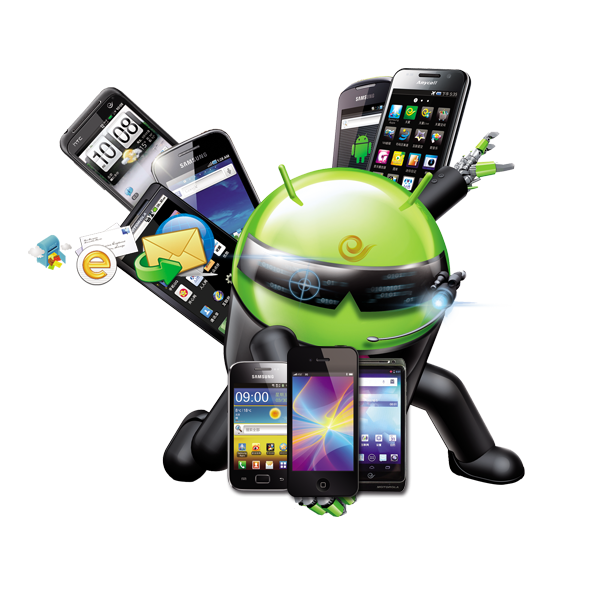Android App Development Using Android Studio Course
Android App Development will open many doors for you, especially if you are looking to becoming a full-fledged app developer. If you’re Looking to boost your income as an Android Developer? Maybe you have a lot of app ideas but don’t know where to start? Or you are seeking a career in Android Development and Java Programming that will finally give you freedom and flexibility you have been looking for?
Build a strong foundation in Android Development, Android Studio and object-oriented Java Programming with this tutorial and complete course.
WHY ANDROID?
Android is known to be one of the most versatile and most used operating systems. We are in the age where every other person uses a handheld device or a cell phone which makes use of Android. If one goes deep into the world of android, we would see that there is a scope and a lot of potential in the world of android for individuals who are tech geeks (like us)! As vast this world this, learning about it as simple and as easy as a piece of cake. You can make your own app easily and show your true potential to the world of google and android.
Why learn android development?
Learning android development is both fun and can reap you many profits in the long run. It is said that by the year 2018, there will be about 4 billion android users, hence doubling the current market. It is safe to say that android development has a potential and can reap you various benefits in the long run. If one knows android development, not only will you be having a stable and sound career but can unleash you hidden talents as a developer.
Android App Development using Android Studio. This curriculum guides students from the basics of Android Studio and app development through to more advanced topics like backend integration, data storage, and publishing on Google Play.
Course Overview:
Duration: 12–16 weeks
Level: Beginner to Intermediate
Prerequisites: Basic programming knowledge (preferably in Java or Kotlin)
Goals: By the end of the course, students will be able to design, develop, test, and publish a functional Android application.
Module 1: Introduction to Android Development and Android Studio (Weeks 1–2)
- Overview of Android Development
- Introduction to the Android operating system and app ecosystem.
- Overview of the Android architecture and app components (Activities, Services, Content Providers, Broadcast Receivers).
- Getting Started with Android Studio
- Setting up Android Studio and configuring the Android SDK.
- Exploring the Android Studio interface and tools: Project Structure, Logcat, Emulator, and AVD.
- Creating the first project: “Hello World” app.
- Introduction to Android Project Structure
- Understanding Android project files and folders: src, res, AndroidManifest.xml.
- Overview of Gradle and how to manage dependencies.
- Basic debugging tools and techniques in Android Studio.
- Basic UI Design and XML Layouts
- Introduction to XML and designing user interfaces.
- Working with common UI components: TextView, Button, ImageView, EditText.
- Understanding dp and sp for responsive design and scaling.
Module 2: Core Android Concepts and UI Design (Weeks 3–4)
- Layouts and View Groups
- Exploring different layouts: LinearLayout, RelativeLayout, and ConstraintLayout.
- Using ConstraintLayout for responsive, flexible design.
- Nesting layouts and managing view hierarchies.
- User Interaction and Event Handling
- Adding onClick listeners and basic event handling.
- Handling different types of user input: Text, Buttons, Checkboxes, and Radio Buttons.
- Using Toast messages and Snackbar for feedback.
- Activities and Intents
- Introduction to Activities and the Activity lifecycle.
- Using Intents to navigate between screens.
- Passing data between activities using Bundles and Intent Extras.
- Fragments and Fragment Management
- Understanding Fragments and their lifecycle.
- Implementing Fragment transactions and managing Fragment backstack.
- Best practices for using Fragments in multi-screen apps.
Module 3: Working with Data and Networking (Weeks 5–6)
- Data Storage in Android
- Using SharedPreferences for lightweight data storage.
- Working with SQLite databases using Room Persistence Library.
- Storing data in files and using internal vs. external storage.
- RecyclerView and List-Based UI Components
- Introduction to RecyclerView for efficient lists and grids.
- Creating custom item layouts and using ViewHolder pattern.
- Adding click listeners to RecyclerView items.
- Networking and APIs
- Introduction to REST APIs and JSON parsing.
- Using the Retrofit library for network requests.
- Using AsyncTask and Kotlin Coroutines for background tasks.
- Displaying and Parsing Data from APIs
- Parsing JSON responses and displaying data in the UI.
- Error handling and managing API responses.
- Implementing basic caching mechanisms for API data.
Module 4: Advanced UI Components and User Experience (Weeks 7–8)
- Material Design and Styling
- Introduction to Material Design guidelines and components.
- Using themes, styles, and custom attributes.
- Adding App Bar, Toolbar, and customizing the Status Bar and Navigation Bar.
- Navigation Component and Advanced UI Navigation
- Setting up navigation using the Navigation Component.
- Working with navigation graphs and handling deep links.
- Implementing bottom navigation and navigation drawers.
- Working with Animations
- Using view animations: fade, scale, rotate, and translate.
- Implementing property animations for custom transitions.
- Using MotionLayout for complex animations and transitions.
- Notifications and Background Services
- Setting up push notifications and creating custom notifications.
- Understanding foreground services and background tasks.
- Using WorkManager for background processing and scheduled tasks.
Module 5: Advanced Android Concepts (Weeks 9–10)
- Firebase Integration
- Setting up Firebase for Android.
- Using Firebase Authentication for user login.
- Storing and retrieving data with Firebase Firestore.
- Using Sensors and Location-Based Services
- Accessing device sensors: accelerometer, gyroscope, etc.
- Implementing Google Maps and location-based services.
- Using the Location API to get and display the user’s location.
- Integrating Media and Camera
- Using the Camera API to take photos and videos.
- Integrating image and video display in apps.
- Using MediaPlayer to play audio and video files.
- Data Binding and MVVM Architecture
- Introduction to data binding for efficient UI updates.
- Understanding the MVVM (Model-View-ViewModel) architecture.
- Using LiveData and ViewModel for lifecycle-aware data management.
Module 6: App Testing, Optimization, and Publishing (Weeks 11–12)
- Testing and Debugging Android Applications
- Writing unit tests and UI tests with JUnit and Espresso.
- Using Android Studio Profiler for performance optimization.
- Debugging common issues: memory leaks, UI performance, and ANRs.
- Optimization for Performance and Responsiveness
- Optimizing layouts and RecyclerView for performance.
- Reducing app size with ProGuard and R8.
- Best practices for energy efficiency and battery management.
- Preparing for App Release
- Creating signed APKs and configuring release builds.
- Using version control and managing app updates.
- Google Play guidelines, app descriptions, and metadata requirements.
- Publishing to Google Play Store
- Setting up a Google Play Developer account.
- Uploading APKs and configuring app store listings.
- Understanding Google Play Console for tracking app performance.
Final Project and Wrap-Up (Weeks 13–16)
- Capstone Project: Complete Android Application
- Students will develop a full-featured app using the learned concepts.
- App must include key features: multi-screen navigation, data storage, and API integration.
- Presentation and peer feedback on final projects.
- Review and Q&A
- Recap of all major topics and open questions.
- Tips for continued learning, resources, and industry trends.
- Advice on portfolio-building and job preparation in Android development.


